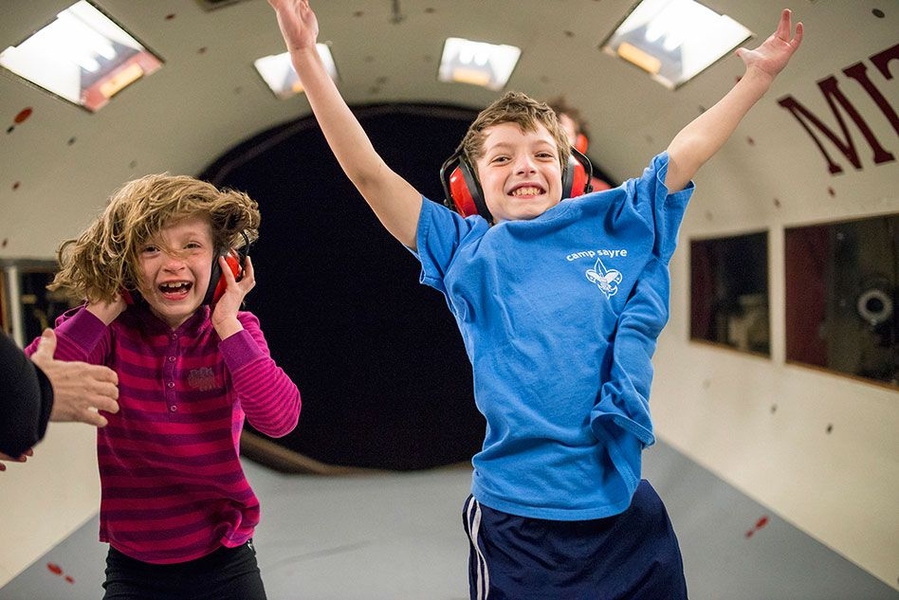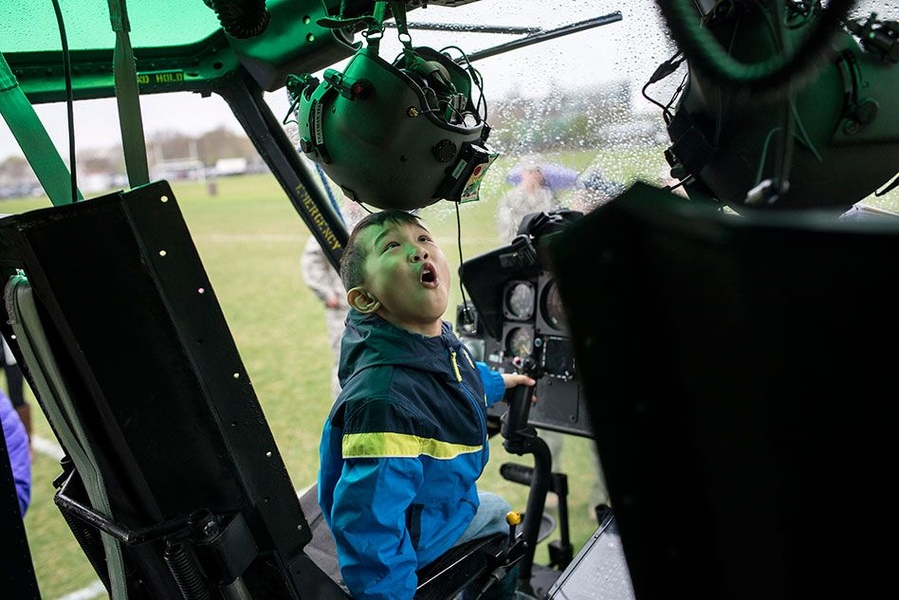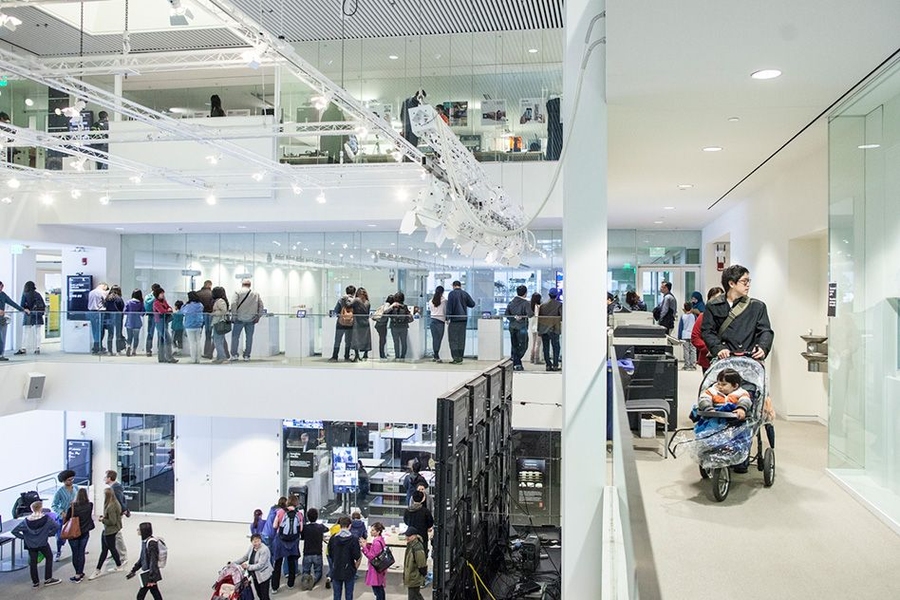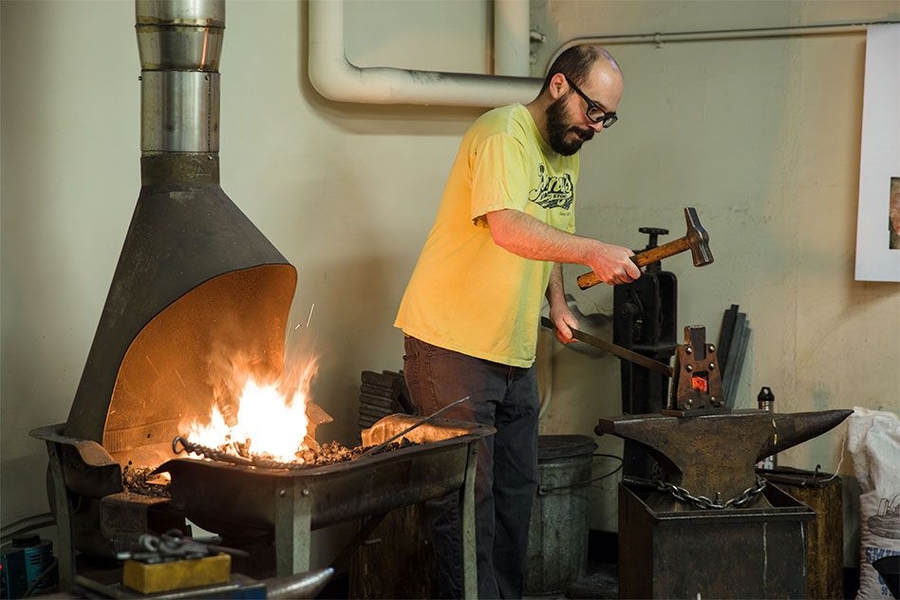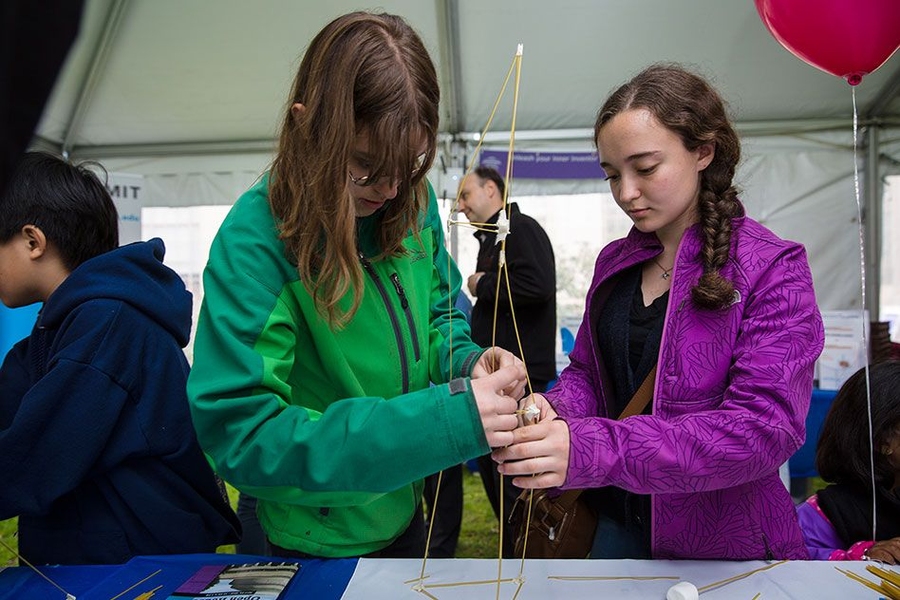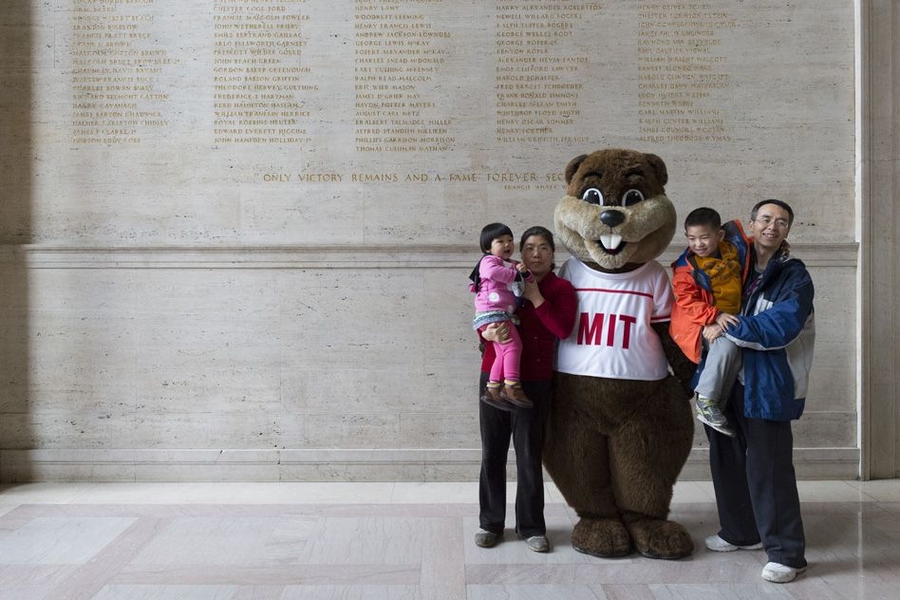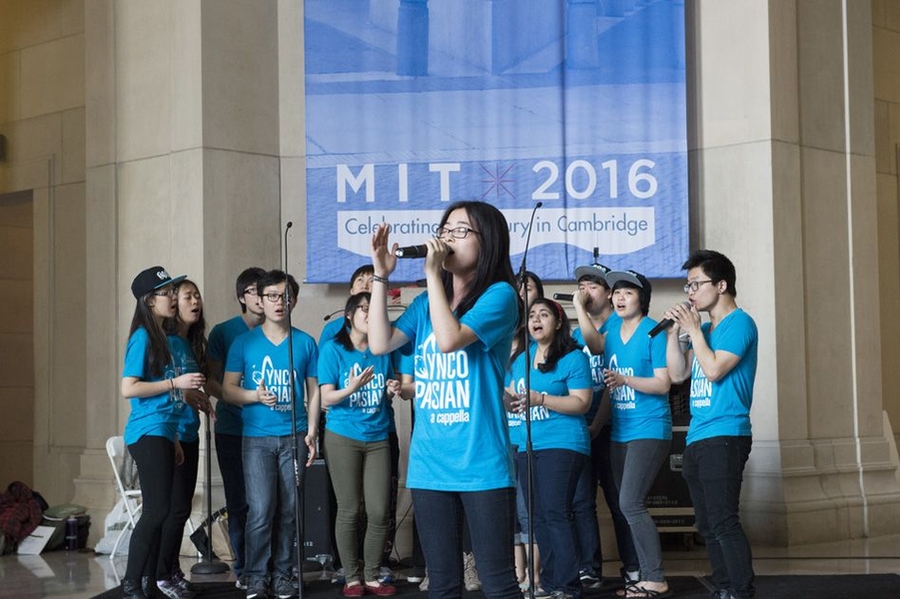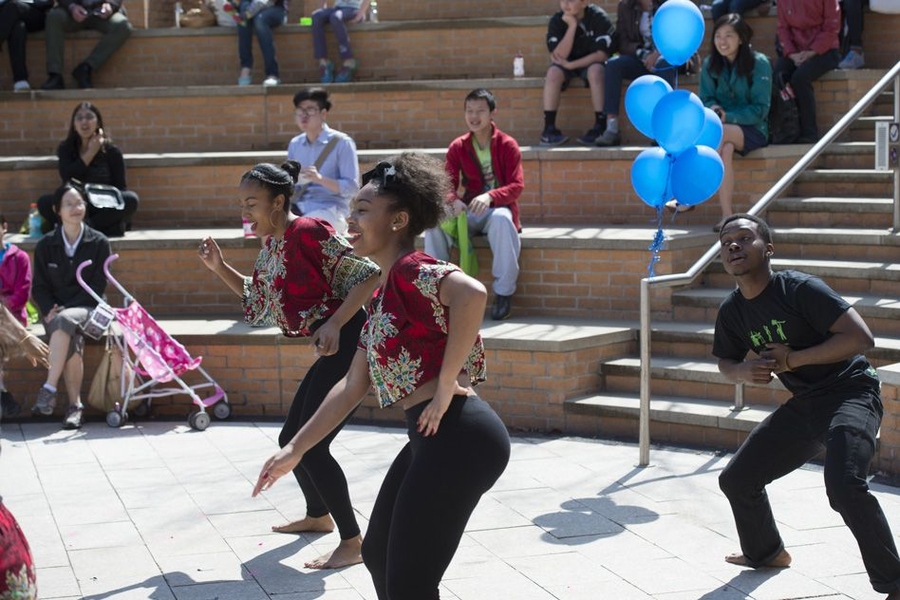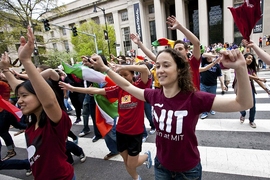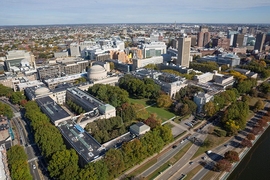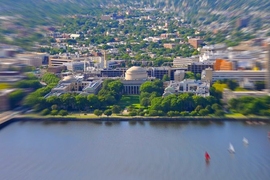On Saturday, around 20,000 visitors were expected to arrive on MIT’s doorstep for a peek “Under the Dome,” in the Institute’s first open house since 2011. Judging from the weather — a stubborn drizzle that dominated much of the morning — those numbers appeared optimistic at first. Instead, they turned out to be more than modest: At the end of the day, as grey skies finally gave way to blue, more than 40,000 people had turned out to see, hear, and play with MIT’s many offerings.
Together, nearly 80 departments and labs hosted more than 380 activities, held in 170 locations across campus. From 10 a.m. to 3 p.m., visitors had the chance to sample ongoing research displayed in MIT’s courtyards and public spaces, from self-driving golf carts to 3-D-printed ice cream. They also sat in on special lectures given by eight distinguished faculty members, on topics ranging from the history of gravitational wave detection, to the future of biomaterials, and humans’ journey to Mars.
Visitors were also invited to dive into MIT’s labs and classrooms, many of which are otherwise hidden from view or even located within the labyrinth of MIT’s tunnel system. These include the Forge, where blacksmiths hammered and molded red-hot steel, and the Glass Lab, where glass blowers spun orbs out of molten glass — both of which hosted long and patient queues.
Robots played a prominent role in attracting crowds, including an industrious automaton named Baxter, designed with soft hands, that was working hard in the Student Street of the Stata Center, sorting household objects, including laundry, blocks, a Magic 8 ball, and a game controller, to the delight of eight-year-old Rand Beatty, of Stow, Massachusetts.
“It’s always been my dream to go to this college — I’m really into everything they do here,” Beatty said. When asked about his favorite activity of the day, he replied: “It’s very hard. It’s pretty much a tie between everything I’ve seen!”
River crossing
The Open House is one of a series of events this spring that mark MIT’s Centennial Crossing — the 100th anniversary of the Institute's move from Boston, across the Charles River, to Cambridge. The Institute commemorated the milestone with a floating pageant, led by a barge named the Bucentaur — a 60-foot-long, plaster-of-Paris vessel decorated with mermaids, cupids, and a beaver. The barge ferried technology officers across the river and featured a “figure of Technology” holding a T-square and a torch of enlightenment.
On May 7, MIT will reenact its 1916 river crossing in a similar procession, with innovative floats and vessels made by members of the MIT community, led by a modern-day Bucentaur. Visitors to MIT’s Open House got a sneak peek of the barge, displayed on Killian Court.
“We’re asking people to write their best wishes for MIT for the next 100 years, or ideas of new technology they expect to see in the next 100 years, and attach them to the boat, like a floating time capsule,” said Sam Magee, manager of MIT’s Student Arts Programs.
As a small crowd of visitors clad in ponchos and raincoats leaned in for a closer look at the barge, Magee scrambled for more pens and paper.
“I think this day is wonderful,” Magee said. “If we want to tell our story, this is the way to do it, to invite people in and check it out.”
New ideas
Across campus, the Media Lab opened its doors to visitors, displaying its many inventive and often quirky ideas, from interactive artwork made from drinking straws and LEDs, to living, breathing clothing.
As she ran across the third floor, eight-year-old Elin Palm stopped short at a window display of microscopes, and exclaimed, “I have one of those!”
Her mother, Kirsten, followed close behind. “We’ve heard about this facility in a lot of different contexts, so it’s nice to be able to see it in person and get a sense for what it feels like here, and then expose our minds to lots of different new thinking that’s happening,” Palm said.
Indeed, visitors had a chance to see and hear plenty of new ideas brewing at MIT. Some explored the Institute’s entrepreneurial efforts in a showcase of 75 student demos, prototypes, and presentations at the newly opened Samberg Conference Center in the Morris and Sophie Chang Building, while others sat in on classroom talks on topics ranging from the science of climate change, to the invisible role of neutrinos in the universe, and the role of mathematics in the real world.
In a classroom within the recently renovated Building 2, home of the Department of Mathematics, 10-year-olds Connor Lien and Max Lee eagerly clicked across a computer screen displaying MIT’s Mathlets — interactive Javascript apps that are designed to introduce mathematical concepts in engaging ways.
“It looks like it’s on 3-D, though it’s on a 2-D screen,” Lien said. “It’s trial and error. I have no idea what I’m doing, but I’m having fun doing it.”
Hands-on
Doing and making were major themes at this year’s open house, and there were plenty of opportunities for hands-on building, and even dismantling. Along the river, in the Simmons building, the Information Systems and Technology Department hosted computer disassembling sessions for groups of 10, in which visitors helped to take apart an entire computer, learning its inner workings, piece by piece.
Meanwhile, the Neumann Hangar was abuzz with maker activity, as the Department of Aeronautics and Astronautics held model airplane-building workshops and a paper airplane competition, with designs inspired by modern aircraft technology. Visitors also had a bit of fun with an improvised air cannon, first making their own paper rockets, then launching them from a bicycle pump-powered launch tube toward an array of balloon targets.
In the Johnson Athletic Center, a steady crowd of people drove small, semiautonomous robots around miniature cities populated with thousands of rubber ducks. The project, named Duckietown, is part of an advanced autonomy class at MIT, designed in a playful way to test how self-driving cars might share the roads in the future. As kids crowded in to play with the ducks and take a turn at driving a shared-control robot, Liam Paull, a postdoc in the Computer Science and Artificial Intelligence Lab, spoke about the project over an enthusiastic din of “quacks.”
“We want to appeal to a wider demographic than we otherwise would with a standard model of robotics, which is something more aggressive and powerful and ‘scary’ to some,” Paull said. “We haven’t had much sleep this week, but so far, we’ve had a great turnout.”
Walkthroughs in science
Tours of MIT’s labs and facilities also proved popular. Visitors followed signs to off-the-beaten-path workspaces, such as nanotechnology clean rooms in Building 39, and the Space Propulsion Lab in Building 37, where students gave guests a view of a car-sized vacuum chamber used to test tiny electric thrusters designed to power future spacecraft.
At the northwestern corner of campus, groups of 25 visitors were treated to a walkthrough of MIT’s fusion reactor, Alcator C-Mod — the largest fusion reactor operated by any university — where researchers are testing safer and less wasteful ways to produce nuclear power.
And across campus, people donned earmuffs for a few breathtaking minutes in the Wright Brothers Wind Tunnel, a facility that has been testing the endurance of aircraft, vehicles, aerospace components, and architectural parts for more than three-quarters of a century. After his wind tunnel experience, seventh grader Finn Felson received a certificate: “Distinguished Wind Tunnel Model Subject.”
“It’s hard to explain, but it felt really weird to try to stand and keep your balance while the wind was continuously coming at you,” Felson said. “It was kind of fun to see the difference between a regular windstorm and a wind tunnel that was recreated using science.”
Outside tinkering
Later in the day, as the sun peeked through, then eventually took over the rain clouds, visitors spilled into MIT’s courtyards to sample from a dozen food trucks stationed across campus. They also took in a regular rotation of musical offerings, from student a cappella and rock-band performances, to a noontime marching band on Kresge Lawn, and theatrical acts by MIT’s Shakespeare Ensemble performed in the Stata Center’s Dertouzos Amphitheater.
On the plaza outside the Ronald E. McNair building, music drew a small crowd to a white, tower-like structure called PrepHub. Designed by researchers at MIT’s Urban Risk Lab, the tower is built around a small photo booth and attached to an L-shaped bench with a pedal-powered charging station at one end. The structure is designed for times of emergency, so that people can gather to hear news updates, charge their devices, and send selfies to worried friends and family. On any other day, such as today, it’s designed to bring communities together.
“Today’s been really exciting,” said Miho Mazereeuw, director of the Urban Risk Lab. “I’ve seen a lot of cool things that I didn’t know were going on here. We’re all tinkering away in our labs, but this is our chance to open it up to the public and to each other.”
